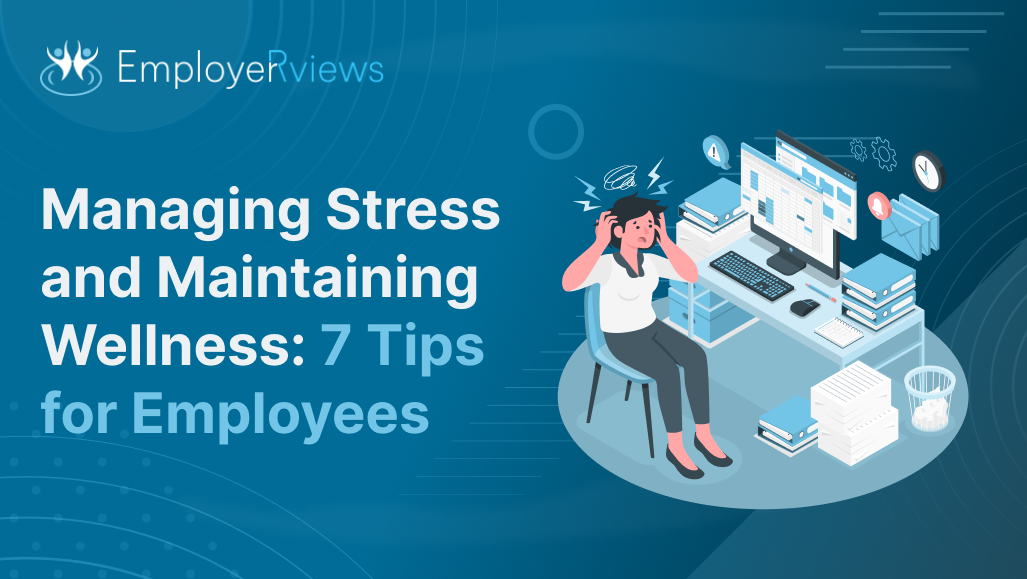
 Don't have an account yet? Sign Up
Don't have an account yet? Sign Up

The pursuit of work-life balance has become increasingly difficult in today's bustling work environment, where deadlines are looming, and responsibilities are piling up. Managing several responsibilities hurts mental and emotional health, thus it is more important than ever to practice effective employee stress management. This blog serves as a compass, providing useful advice and doable tactics to enable people to successfully navigate the complex obstacles of the contemporary workplace while placing a premium on mental health and general well-being.
Together, let us go out on this journey to employee stress management and maintaining wellness, peeling back perceptive nuggets of wisdom one by one for a more satisfying and harmonious work-life balance.
Tip 1: Setting Realistic Goals
Unrealistic tasks and objectives can greatly increase employee stress and wellness interventions. Workers and managers should collaborate to establish realistic goals and deadlines, making sure that expectations match the resources and skills at their disposal.
Tip 2: Establishing Work-Life Balance
For employee wellness management, maintaining a healthy work-life balance is essential. A balanced lifestyle can be achieved by establishing boundaries between work and personal life, turning off work emails after hours, and taking breaks during the working day.
Tip 3: Professional Development Opportunities
Investing in professional development can empower employees and lessen employee stress and wellness interventions that come with job instability. Workshops, training courses, and opportunities to improve one's skills all contribute to a sense of growth and achievement.
Tip 4: Effective Time Management
Stress levels can rise due to poor time management. Adopting time management strategies, such as prioritizing work, making to-do lists, and segmenting large projects into smaller, more manageable chores, can help in employee wellness management.
Tip 5: Promoting Social Connections
Developing close social connections at work can reduce stress and feelings of isolation. Companies can set up social gatherings and team-building activities or create spaces for informal staff interactions.
Tip 6: Mindfulness and Relaxation Techniques
Educating staff members on mindfulness and relaxation techniques, such as meditation or deep breathing exercises, can help them stay focused and manage stress. Employers can encourage these methods by providing tools or workshops.
Tip 7: Promoting a Supportive Workplace Culture
It is essential to establish a supportive work environment. Open communication, teamwork, and workplace stress management resources should all be promoted by employers. An encouraging work environment makes workers feel appreciated and supported.
As we conclude the article, it becomes clear that a proactive approach to mental health not only enhances individual satisfaction but also contributes to a thriving workplace stress management culture. Embracing practical strategies like effective time management, realistic goal-setting, and mindfulness practices empowers employees to fortify their resilience against the challenges of modern work life.
This journey toward holistic well-being is ongoing, and the power to create a healthier and more balanced work environment lies within everyone. By implementing these tips and fostering a culture that prioritizes mental health, we can collectively build workplaces where employees not only succeed professionally but also thrive personally. Remember, a resilient and fulfilled workforce is the cornerstone of a vibrant and successful organization.
For more personalized insights and connections, join Employer View, the ultimate platform fostering seamless connections between employees and employers.
What are some practical strategies to manage stress in a busy work environment?
Some practical strategies for managing stress includes; prioritize tasks, practice effective time management, and incorporate short breaks for relaxation throughout the day. Apart from this, start adopting mindfulness techniques such as deep breathing or meditation.
Are there any specific techniques that individuals can adopt to improve their mental health in the workplace?
Yes, techniques such as goal setting, regular self-assessment, and fostering a positive mindset can contribute to enhanced mental health.
How does regular exercise contribute to stress management, and which activities are recommended for busy professionals?
Exercise releases endorphins, which reduce stress hormones and improve mood. Additionally, short activities like walking or stretching during breaks can have a positive impact on both physical and mental well-being.
How can fostering social connections at work contribute to a healthier and enjoyable work environment for employees?
Social connections provide emotional support, reduce feelings of isolation, and contribute to a positive work atmosphere. Engaging in team-building activities and maintaining friendly relationships with colleagues can improve job satisfaction and overall well-being.
How can employees strike a balance between work and personal life to maintain overall well-being?
Employees should set clear boundaries, prioritize self-care, and interact openly with supervisors about workload. Establishing a healthy work-life balance involves making intentional choices to protect personal time.
What are some signs of burnout, and how can employees recognize and address these signs in themselves?
Fatigue, decreased job satisfaction, and a decline in performance are some signs of burnout. Employees should be aware of these indicators, communicate with supervisors about workload, and consider seeking professional assistance if needed.